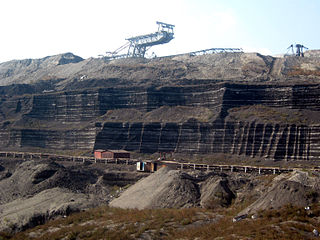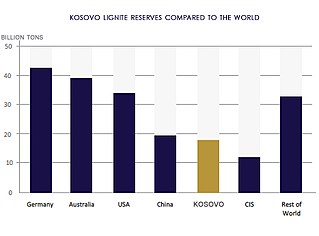
Lignite, often referred to as brown coal, is a soft, brown, combustible sedimentary rock formed from naturally compressed peat. It has a carbon content around 25–35%, and is considered the lowest rank of coal due to its relatively low heat content. When removed from the ground, it contains a very high amount of moisture which partially explains its low carbon content. Lignite is mined all around the world and is used almost exclusively as a fuel for steam-electric power generation.

The economy of Kosovo is a transition economy. Kosovo was the poorest province of the former Yugoslavia with a modern economy established only after a series of federal development subsidies in the 1960s and the 1970s.

The Ministry of Coal is an Indian government ministry headquartered in New Delhi. The portfolio is held by Cabinet Minister Pralhad Joshi.
Coal mining regions are significant resource extraction industries in many parts of the world. They provide a large amount of the fossil fuel energy in the world economy.

The Miraš open-cast coal mines are lignite coal mines in Kosovo operated by the Kosovo Energy Corporation (KEK).

Coal in India has been mined since 1774, and India is the second largest producer and consumer of coal after China, mining 777.31 million metric tons in FY 2022. Around 30% of coal is imported. Due to demand, supply mismatch and poor quality with high ash content, India imports coking coal to meet the shortage of domestic supply. Dhanbad, the largest coal producing city, has been called the coal capital of India. State-owned Coal India had a monopoly on coal mining between its nationalisation in 1973 and 2018.
Motru Coal Mine is an open-pit mining exploitation, one of the largest in Romania located in Motru, Gorj County. The legal entity managing the Motru mine is the National Company of Lignite Oltenia which was set up in 1997.
Husnicioara Coal Mine is an open-pit mining exploitation, one of the largest in Romania located in Husnicioara, Mehedinți County. The legal entity managing the Husnicioara mine is the National Company of Lignite Oltenia which was set up in 1997.
Anina Coal Mine is an underground mine that is now closed. It was one of the largest mines in Romania. It is located in South-Western Romania, in Anina, Caraș-Severin County in the historical Banat region. The mine still has large reserves of anthracite, lignite, brown coal and oil shale amounting to over 1.3 billion tonnes. It was owned by Miniera Banat a state owned company that specialised in the management of coal mines in the Banat region. The mine opened in 1790 making it the longest running mine in Romania until its closure in 2006. Its galleries are hundreds of kilometers in length and reach a depth of 1,200 metres (3,900 ft) making it the deepest mine in Romania and one of the deepest in Europe. The mine supplied oil shale to the nearby Crivina Power Station, a 990 MW thermal power station, the first oil shale power station in Romania, that had to be supplied with around 4 million tonnes of oil shale per year.

The Bełchatów coal mine is a large open-pit mine in the centre of Poland in Bełchatów, Łódź Voivodeship, 150 km west of the capital, Warsaw. Bełchatów represents one of the largest coal reserve in Poland having estimated reserves of 1,930 million tonnes of lignite coal. In 2015, the mine produced 42.1 million tonnes of lignite to feed Bełchatów Power Station.

The Turów coal mine or KWB Turów, is a large open pit mine in the southwest of Poland, located outside Bogatynia, Lower Silesia. It feeds the nearby Turów Power Station. In March 2024 a Warsaw court found the EIA for mining from 2026 to be invalid, but the owner is appealing. Unlike the other coal-dependant parts of Poland, a just transition for coal phase-out has not yet been planned as of 2024.
The Legnica coal mine is a proposed lignite mine in the west of Poland in Legnica, Lower Silesian Voivodeship, 355 km west of the capital, Warsaw. Legnica represents one of the largest coal reserves in Poland having estimated reserves of 2,504 million tonnes of coal. In 2009, a local referendum in Kunice, Ruja, Miłkowice, Prochowice, Ścinawa, and Gmina Lubin decided against the construction of the mine. As of 2023, the Legnica coal mine was not constructed or in construction.
The Gubin coal mine was a proposed lignite mine in the west of Poland in Gubin, Lubusz Voivodeship, 350 km west of the capital, Warsaw. The Gubin deposit has estimated reserves of 282.7 million tonnes of coal.

Kosovo B Power Station is the largest power station in Obiliq, Kosovo. It is a lignite-fired consisting of 2 units with 340 MW generation capacity, which share a 183 metres (600 ft) tall chimney with 6.8 metres diameter at the top.
Natural resources are abundant in Kosovo. Kosovo is mainly rich in lignite and mineral resources such as: coal, zinc, lead, silver and chromium, but also with productive agricultural land. Kosovo is also rich in forests, rivers, mountains and soil; Kosovo is especially rich in coal, being aligned among European countries as the third with the largest coal reserves. Kosovo possesses around 14,700 billion tons of lignite in reserves, which aligns Kosovo as the country with the fifth largest lignite reserves in the world.
The Belaćevac coal mine is a coal mine in Obilić in District of Pristina, Kosovo. The mine has coal reserves amounting to 5.92 billion tonnes of lignite, one of the largest lignite reserves in Europe. It produces 6.2 million tonnes of coal per year.

Elbistan coalfield, also known as Afşin Elbistan Lignite Reserve, is a large lignite coalfield located in the south-east of Turkey in Kahramanmaraş Province. Elbistan is the field with the most coal in Turkey. Kışlaköy coal mine now mines the field. 200 million tons of CO2 were emitted by burning lignite from this field before 2016, and 2.4 billion tons could be emitted in future. The lignite is high in sulfur and moisture, and only has 1,000 to 1,500 kcal/kg, or less than 5 MJ/kg, which is a quarter of typical thermal coal. The coalfield supplies the Afşin-Elbistan power stations.

Kosovo has a slowly developing plain industry. In 2009, the Industry accounted for 22.60 of GDP and a general workforce of 800,000 employees. It's on 150 th place, compared to the rest of the world. There are numerous reasons for this kind of stagnation, ranging from consecutive occupations, political turmoil and the recent Kosovo War (1999).

Lignite coal in Kosovo is and will continue to be an important local energy source due to its high reserves. Kosovo is very rich in lignite and accounts around 90% of Kosovo's electricity production. The nation has the 5th largest lignite reserves in the world and the 3rd in Europe. The lignite is distributed across the Kosovo, Dukagjin and Drenica Basins, although mining has so far been restricted to the Kosovo Basin. The lignite is of high quality for the generation of electricity and compares well with the lignite resources of neighbouring countries on a range of parameters. Kosovo's lignite varies in net calorific value from 6.28-9.21 MJ/kg, averaging 7.8 MJ/kg. The deposits can be up to 100 m thick, but average 40 m, and possess an average strip ratio of 1.7:1.











